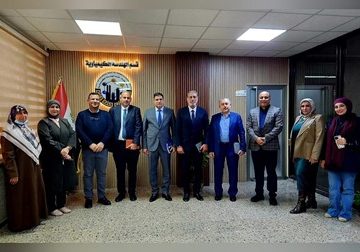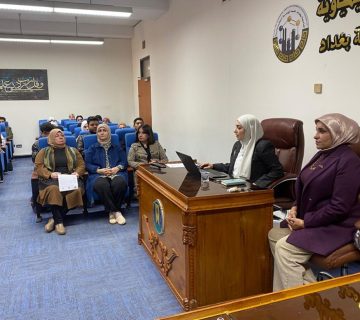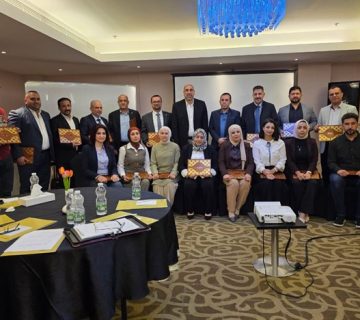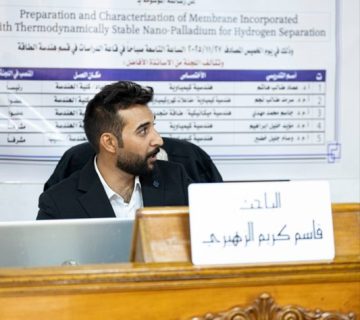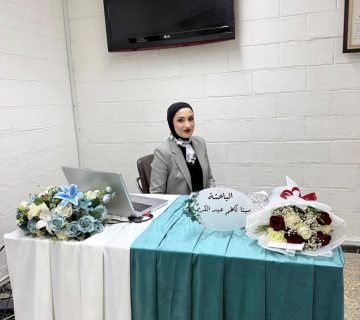The Chemical Engineering Department at the College of Engineering, University of Baghdad, held a M.Sc. thesis examination titled:
“ Functionalization of Carbon Nanotubes for Carbon Dioxide Capture ”
By the student “Ibrahim Farhan Hassan” and supervised by Prof. Dr. Najwa Saber Majeed. The examination committee consisted of Prof. Dr. Mohammad Dakheel Salman as Chairman and the membership of Asst. Prof. Dr. Nada Naoum Abdulrazak, Lec. Dr. Suheila Abdalreda Akkar. The thesis was accepted after conducting a public discussion and listening to the student’s defense. The thesis was summarized as follows:
The thesis aimed to capture carbon dioxide, which is the main cause of global warming and consequently climate change, by using carbon nanotubes after the activation process.
The first part of the study focused on activating carbon nanotubes using ethylenediamine (EDA) and in a second way using a mixture of nitric and sulfuric acid to improve the physical and chemical properties in order to increase the adsorption capacity.
As for the second part, the adsorption capacity was studied and measured before and after the activation process, then the effect of temperature on the adsorption capacity was studied, the effect of the volumetric flow rate of gases was studied, and the effect of the weight of carbon nanotubes used to adsorb carbon dioxide on the equilibrium curves was studied.
After the extensive study, the thesis recommended the use of carbon nanotubes activated by (EDA) in the adsorption of carbon dioxide gas.
Carbon dioxide (CO2) is the primary factor considered to be responsible for global warming. CO2 capture technology has been considered important issue to decrease greenhouse gases emissions and thus the impact of climate change.
This research investigates the functionalization of Multi Wall Carbon nanotubes (MWCNTs) by Ethylenediamine (EDA) solution and with mixture of H2SO4/HNO3 and then used for CO2 capture at various operating conditions. Surface functionality groups and morphology of MWCNTs and Physical properties were analyzed by X-Ray Diffraction (XRD), Fourier Transforms Infrared Spectroscopy (FTIR), Scanning Electron Microscopy (SEM), Energy Dispersive Spectroscopy (EDS) and surface area Brunauer Emmett and Teller (BET).
The physical and chemical properties of CNTs have changed after the functionalization process, that enhance MWCNTs adsorption for CO2 gas. According to the study results, during the functionalization process, amine groups bound to carbonaceous surfaces created CO2 adsorption sites on multi-walled CNTs, increasing the adsorption capacity of MWCNTs.
The CO2 adsorption capacity was determined by choosing different pressure values from (1 to 7) bar at temperatures (309 and 333) K which is mean that the adsorption capacity is a function of pressure at chosen temperature. The exothermic nature of the adsorption process was indicated by the decreasing CO2 adsorption capabilities by pristine and functionalized MWCNTs with temperature rising. This indicates that MWCNTs are a potential low-temperature adsorbent for CO2 capture.
The results showed that 0.6968 mmol g−1 of CO2 was adsorbed by MWCNT-EDA at 309 K and 7 bar while, MWCNTs-Acid adsorbed 0.5235 mmol g−1 and raw MWCNT only adsorbed 0.3428 mmol g−1 at the same condition. The optimum adsorbent was EDA-MWCNT at 309 K.
Freundlich and Langmuir isotherm models were used to study the experimental data adsorption models, the results have suggested that the Freundlich model fits the experimental data more precisely.
The effect of feed flow rate on breakthrough curves has been studied, three different flow rates was investigated (0.5, 1 and 1.5) l/min with ratio (10% CO2 /90% N2) and the bed weight 1.5 g of MWCNTs. The results showed that increasing the flow rate causing decreasing the equilibrium time due to the decreasing in contact time.
The effect of bed weight on the equilibrium breakthrough curves has been studied using three different bed weights 1, 1.5 and 2 g at steady feed flow rate 0.5 l/m with ratio (10% CO2 /90% N2). The results showed that by increasing the bed weight the equilibrium time increase because the surface area available for adsorption increased and the contact time will be increased.
After the scientific discussion by the members of the discussion committee, listening to the researcher’s defense, and evaluating the thesis, the researcher was awarded a master’s degree in chemical engineering with a very good grade.




